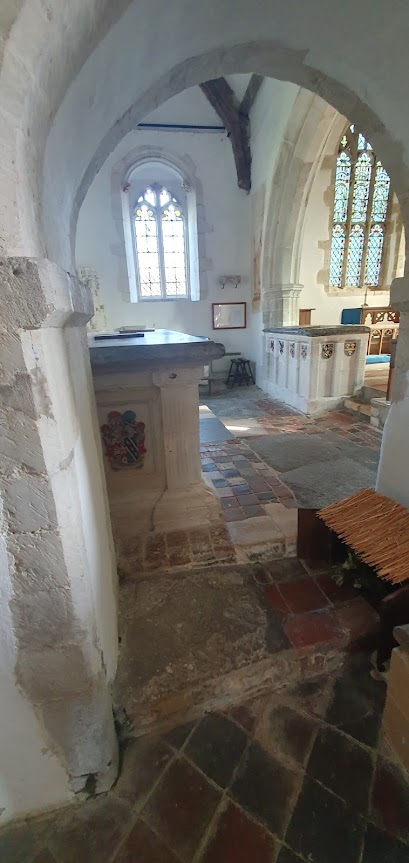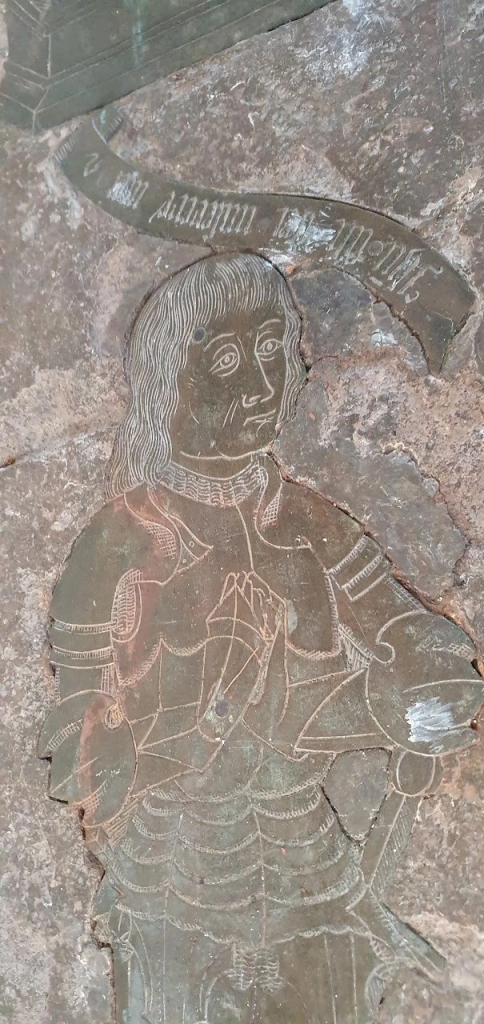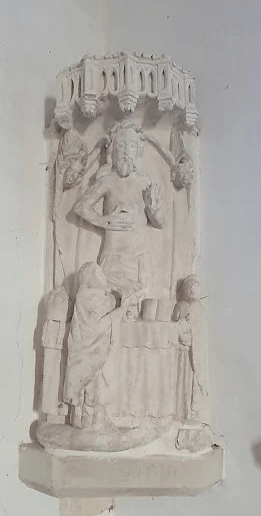Between rainstorms, we were out in the countryside doing some church-crawling, a grand way to do some ‘medievalling’ when long journeys to castles and houses, most still closed for the winter, are out of the question.
We happened on Stoke Charity by pure accident. I was attracted by the unusual name, which also began ringing a few bells….
The church of St Mary and St Michael is tiny, with a small wooden tower. First built in Norman times, it sits in a field, away from the village centre, overlooking a river (which looked more like a lake with all the recent rains). The path to the churchyard was full of lumps and bumps and I guessed that there had once been buildings there–I was right, the original medieval manor house had stood on that very spot.
The church might be small but when we opened the door, it was a veritable treasure chest inside. First, was an Easter sepulchre which had a 15thc tomb complete with brass of a pleasant-looking fellow called Thomas Wayte who died in 1482. Immediately I knew who this was–the possible father of Elizabeth Lucy (nee Wayte), who was one of Edward IV‘s mistresses and mother to Arthur Plantagenet. Elizabeth Lucy is the mistress our friend Thomas More hooved into his fairytale, claiming that Bishop Stillington and Richard III had claimed SHE was the one who had secretly married Edward IV before he bigamously married Elizabeth Woodville and that she had denied such a thing. This seems like pure Tudor obfuscation, as, at this fairly early stage, some must still have remembered that the real woman in question was Eleanor Talbot as written in Titulus Regius. Yes, Henry Tudor had ordered all copies destroyed (one was not, fortunately, so we know what was REALLY written in it) but there were still those alive from that time. Better for Henry, of course, to find a living mistress of King Edward who was NOT an earl’s daughter and add her to the story.
Another great 15th tomb in the church belonged to the Hampton family, who seemed to have some sort of connection to the Waytes. John Hampton, died 1483, has a brass very similar to that of Wayte; his wife is beside them but unfortunately bit of her brass are missing. At their feet is another brass depicting their six daughters and two sons. Four of the girls have wonderful late 15thc headdresses, while the other two are shown with long, free-flowing hair, denoting they were still unmarried at the time.
There is also late 15th c wood carving of St Michael in a protective glass box high on the wall, a rare original carving of the Mass of St Gregory (most were destroyed in the Reformation), some original tiles, and some late medieval glass, including three suns. In the Hampton chapel there is a wall painting which is fragmentary but appears to be of a saint approaching a king–this is older than the monuments around it, likely 13th c.
Definitely a place worth a visit but be careful–parking is on the opposite side of the road and there are no paths on that road–I almost had a tangle with a bus that had the ominous destination of ‘Henry Beaufort‘ blazoned across its front. Yes, really (I presume it is the name of a local school.)
Below is a link to John Ashdown-Hill’s article about Thomas Wayte and Elizabeth Lucy: https://richardiii.net/wp-content/uploads/2021/08/11-145-The-Elusive-Mistress-Elizabeth-Lucy-and-her-Family.pdf





Wonderful! Thank you!
LikeLike
Oh my goodness, my great-great-grandparents were married in that church!
I saw the exterior when I visited the area once, but never got inside – I went to the pub!
After a couple of children, they did what many in the Industrial Revolution did and left the land and followed the work to factories in the north – bottle-making. First in Pontefract/Wakefield, then in Northumberland.
It looks like the interior calls for a second visit… Thank you for the article.
LikeLike
Oh, you must go, it is lovely. The whole village is really pretty.
LikeLike